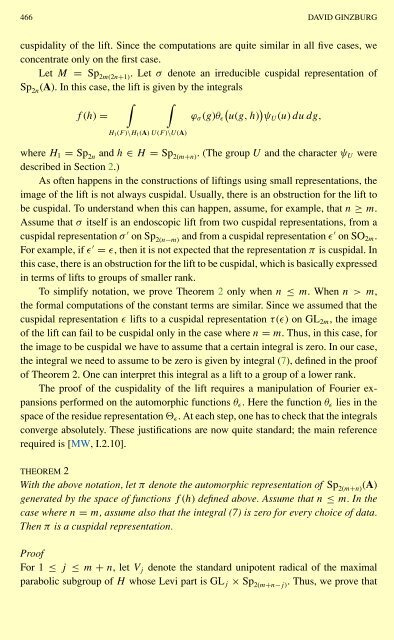A NULLSTELLENSATZ FOR AMOEBAS
A NULLSTELLENSATZ FOR AMOEBAS
A NULLSTELLENSATZ FOR AMOEBAS
You also want an ePaper? Increase the reach of your titles
YUMPU automatically turns print PDFs into web optimized ePapers that Google loves.
466 DAVID GINZBURG<br />
cuspidality of the lift. Since the computations are quite similar in all five cases, we<br />
concentrate only on the first case.<br />
Let M = Sp 2m(2n+1) .Letσ denote an irreducible cuspidal representation of<br />
Sp 2n (A). In this case, the lift is given by the integrals<br />
∫ ∫<br />
( )<br />
f (h) =<br />
ϕ σ (g)θ ɛ u(g, h) ψU (u) dudg,<br />
H 1 (F )\H 1 (A) U(F )\U(A)<br />
where H 1 = Sp 2n and h ∈ H = Sp 2(m+n) . (The group U and the character ψ U were<br />
described in Section 2.)<br />
As often happens in the constructions of liftings using small representations, the<br />
image of the lift is not always cuspidal. Usually, there is an obstruction for the lift to<br />
be cuspidal. To understand when this can happen, assume, for example, that n ≥ m.<br />
Assume that σ itself is an endoscopic lift from two cuspidal representations, from a<br />
cuspidal representation σ ′ on Sp 2(n−m) and from a cuspidal representation ɛ ′ on SO 2m .<br />
For example, if ɛ ′ = ɛ, then it is not expected that the representation π is cuspidal. In<br />
this case, there is an obstruction for the lift to be cuspidal, which is basically expressed<br />
in terms of lifts to groups of smaller rank.<br />
To simplify notation, we prove Theorem 2 only when n ≤ m. Whenn>m,<br />
the formal computations of the constant terms are similar. Since we assumed that the<br />
cuspidal representation ɛ lifts to a cuspidal representation τ(ɛ) on GL 2m , the image<br />
of the lift can fail to be cuspidal only in the case where n = m. Thus, in this case, for<br />
the image to be cuspidal we have to assume that a certain integral is zero. In our case,<br />
the integral we need to assume to be zero is given by integral (7), defined in the proof<br />
of Theorem 2. One can interpret this integral as a lift to a group of a lower rank.<br />
The proof of the cuspidality of the lift requires a manipulation of Fourier expansions<br />
performed on the automorphic functions θ ɛ . Here the function θ ɛ liesinthe<br />
space of the residue representation ɛ . At each step, one has to check that the integrals<br />
converge absolutely. These justifications are now quite standard; the main reference<br />
required is [MW, I.2.10].<br />
THEOREM 2<br />
With the above notation, let π denote the automorphic representation of Sp 2(m+n) (A)<br />
generated by the space of functions f (h) defined above. Assume that n ≤ m. Inthe<br />
case where n = m, assume also that the integral (7) is zero for every choice of data.<br />
Then π is a cuspidal representation.<br />
Proof<br />
For 1 ≤ j ≤ m + n, letV j denote the standard unipotent radical of the maximal<br />
parabolic subgroup of H whose Levi part is GL j × Sp 2(m+n−j) . Thus, we prove that
















